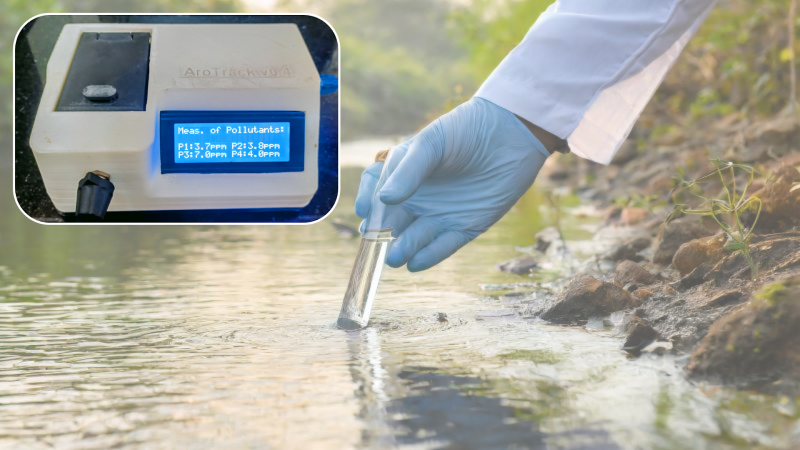
In a significant development for sustainable environmental management, scientists at the Indian Institute of Technology Bombay (IIT Bombay) have introduced an economical and portable device to accurately detect harmful pollutants such as phenol or benzene in water. The device, named AroTrack, can be a game-changer given the increasing water pollution due to industrialisation, urbanisation, and unregulated effluent discharge.
When access to safe drinking water is shrinking, pollution of the remaining freshwater bodies is a serious concern. In cities worldwide, untreated industrial effluents are often discharged into the rivers, bringing in hazardous pollutants like phenol, benzene, and xylenols. Such chemicals, collectively called ‘aromatic xenobiotic’ compounds, are organic compounds that are similar in structure to benzene, consisting of a ring of carbon molecules. In large quantities, the aromatic xenobiotics can be extremely toxic to living organisms and yet difficult to detect.
Over the past few years, such pollutants have resulted in water contamination, leading to health crises with millions of people affected worldwide. For instance, a massive oil spill in Lanzhou, China, exposed about 2.4 million people to benzene. Similarly, in the southern Indian city of Madurai, benzene-contaminated groundwater has increased human health risks. Unfortunately, current methods for detecting aromatic xenobiotics in water are expensive, require skilled technicians, and lack portability, limiting their widespread use.
In a bid to address these challenges, Prof. Ruchi Anand from the Department of Chemistry, Prof. Rajdip Bandyopadhyaya from the Department of Chemical Engineering and their team at the Indian Institute of Technology Bombay (IIT Bombay) have now introduced a simple and affordable biosensing device capable of detecting these harmful compounds.
“AroTrack was born out of the philosophy to make field-usable analytical devices, based on translating analytical capabilities generated in the laboratory into actual field-ready devices. It is designed so that almost any user, technically trained or layman, may quickly learn and generate accurate data for traditionally difficult to measure and distinguish aromatic xenobiotic pollutants,” remarks Prof. Bandyopadhyaya about the motivation behind developing AroTrack.
The IIT Bombay device uses proteins typically found in bacteria living in heavily polluted environments to effectively identify multiple aromatic pollutants in water. Once mixed in the water sample, the protein undergoes a highly selective ATP hydrolysis chemical reaction if an aromatic compound is present in the sample. This reaction is expressed with a change in the colour of the protein solution, which AroTrack can then detect. The device is highly robust and compact, measuring slightly smaller than a small projector.
“AroTrack can do (detect) multiple pollutant aromatic xenobiotics and can be carried to remote places. It is quite small and will also work in rural settings or difficult-to-reach sites,” explains Prof. Anand.
The key component of the device is a biosensing module called MopR - a sensitive sensor for detecting phenol. Prof. Anand’s research team engineered it from the Acinetobacter calcoaceticus bacteria in 2017. MopR is both selective and stable, meaning it can detect pollutants even in complex environments with a high degree of precision. Researchers at IIT Bombay have further diversified the MopR biosensor to detect other pollutants from the benzene and xylenol groups by engineering mutations in the bacterial protein.
“The protein biosensing is very specific as the protein sensing pocket is tailor-made for the ligand (ion or molecule, like phenol or benzene). We have engineered mutations in the DNA of the protein sequence that can give mutant versions of the protein that now sense different molecules, creating a battery of sensors. Each sensor is particularly designed for a ligand,” explains Prof. Anand.
Once interfaced with an in-house, multi-channel monitoring apparatus, the MopR-based sensor forms the core of the newly developed aromatics tracking device—AroTrack. Talking about how the AroTrack detects the pollutants using the biosensor modules, Prof. Bandyopadhyaya explains,
“AroTrack contains a light emitting diode (LED)-phototransistor assembly, that shines a light of appropriate wavelength through the sample and detects how much is absorbed. A more intense colour generates a higher absorbance.”
Despite the complexity of AroTrack’s function, the team managed to keep the overall cost of the device to a minimum of $50 (less than Rs. 5000) without compromising its sensitivity.
“Using in-house 3D printing in our laboratory, we were able to economically design, fabricate and iterate a fully functional device. Also, the cost could be kept down by using basic electronics and open-source, mass-produced microcontrollers for data processing and analysis,” remarks Prof. Bandyopadhyaya.
AroTrack can detect several aromatic contaminants, including phenol, benzene, and 2,3-dimethylphenol, even when these pollutants are present in low concentrations - usually in the 10-200 parts per billion (ppb) range. Tests in simulated wastewater and actual environmental samples have found that the AroTrack is highly reliable, offering a degree of accuracy and efficiency on par with modern spectrophotometers, which are currently used for detection. The device also reliably worked in water temperatures up to 50 degrees Celsius and completed the tests in under 30 minutes.
Moreover, due to its low cost, battery-operated nature, and portability, AroTrack can be ideal for rural and low-income settings that often lack resources and have difficulty accessing expensive laboratory tests.
Explaining the next steps in expanding the capabilities of AroTrack, Prof. Anand says, “We are currently trying to increase the type of pollutants to biphenyl aromatics and pollutants that are complex aromatics ”.
Speaking about its market readiness, Prof. Bandyopadhyaya adds, “The product is ready as an initial functional prototype, which can demonstrate all the reported functions. To make it fully market-ready, more field trials and quality analysis are needed to assess its robustness under more varied working conditions in the field, with a wider variety of water sources and compositions.”
The AroTrack device underscores the significant potential of employing low-cost, open-source electronic components to create field-ready, environment-monitoring devices. As a viable alternative to traditional analytical technologies, it has the potential to revolutionise how we test water quality—a critical first step toward a safer, healthier world.






